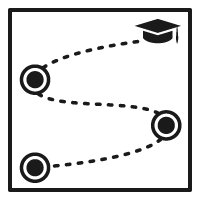Addressing Student Choice in Assignment Submissions

Assessments are one of the most critical elements of a course. Not only are they the activities students engage in, but they’re also the measure of whether students have mastered your learning objectives. As such, it’s essential that you maximize the impact they can make.
While the traditional model of assessment requires students to all complete the same activity, newer instructional models and technology support allowing students the opportunity to demonstrate their learning in unique ways that are relevant to their learning preferences, career goals, and more. Fortunately, adding an element of student choice to your students’ assignment submissions does just that. In this article, we’ll discuss a few strategies you can employ to begin addressing student choice in your online course assessments.
Universal Design for Learning

It’s hard to discuss student choice without acknowledging universal design for learning (UDL). At its core, UDL is an instructional design framework that acknowledges the fact that every student comes into a classroom with a preset preference for how he or she learns. Disabilities, cultural differences, and even past educational or professional experiences can shape how students prefer to learn and demonstrate that learning, and UDL suggests that we address these preferences by designing for the margins.
The idea behind “designing for the margins” is that many courses are designed for the “average” student. In most situations, though, that student doesn’t necessarily exist. Every person learns (and prefers to showcase that learning) in a slightly different way. Thus, instead of designing with this average student in mind, we need to plan for the idea that there will be differences in learning between students and focus design decisions on the needs of those at the margins of “normal.” When you do this, you also meet the needs of those between those margins.
What does this have to do with student choice in assignments, though? While this article covers the ins and outs of this in further detail later, the crux of it is that student choice is one way you can begin designing for the margins. By building a structure that allows students to select how they demonstrate their learning, you encourage them to play to their strengths, challenge their weaknesses, and take control of their educational experience. Because students individually guide this process, there’s no average student to consider. The needs of everyone are met.
For more information on UDL, including the neuroscience research and the different brain networks it acknowledges, we recommend exploring CAST’s resources on the subject.
Strategies for Addressing Student Choice
While there’s tremendous value in allowing your students to have a say in how they demonstrate their learning, as with any course design endeavor, it’s important to do so in a way that’s purposeful and appropriate for your subject matter and audience. To do this, consider the following tips:
Build in Goal Setting

One way to frame a discussion on student choice is to look at goal setting, which can be used as a powerful way to encourage higher levels of performance. Essentially, goal setting can positively impact the student experience by not only offering various methods of action, but by helping students visualize what they want. This, in turn, can frame their assignment submission choices. For instance, in an education course, you could ask students to visualize their career goals. Where do they want to teach? What subject matter? Are there any specific activities or classroom design elements they’d like to use? Then, if the course asks them to develop a classroom management plan, for instance, they can keep those goals in mind. The goals can inform what the submission ends up looking like, giving students choice in the matter and making the assessment relevant to their careers.
Just like it can be important to give students a degree of choice in these assignment submissions, it’s equally important to give students choice in how they set their goals. Some students, for example, prefer to write out goals in paper-based planners. Other students benefit from checklists of recommended steps. Similarly, a course could include estimates on how much time students need to set aside for schoolwork and studying, or an hour-by-hour planning sheet that they can use to identify work schedules, personal commitments, and planned study time. By focusing on different methods of time management and goal setting, it becomes more likely that all students will find a way that works best for them.
Ultimately, by considering individual students’ goals (and building that goal-setting process into the course), you can help them shape what their interests might be and how they might explore those interests when it comes to flexibility in their assignment submissions.
Broaden Learning Objectives

When making any course design decision, it’s important to consider your learning objective. When you’re talking about student choice, though, it can be helpful to see if there’s an opportunity to broaden what you expect of students. This can be an important time to remember the course design triangle and your instructional alignment. When doing so, ask yourself, is the skill or verb of my learning objective absolutely essential for demonstrating competence?
If possible, it can be helpful to broaden learning objectives that might be just as effective if they’re open for student choice. For instance, could students “construct a persuasive argument” instead of “write a persuasive essay”? The former allows for some flexibility—students could record themselves delivering a persuasive speech, have a call with you in which they try to persuade you of their point, or even just write the persuasive essay—whereas the latter option restricts what students can do. If you can broaden your learning objectives in such a way that students can make their submissions fit their personal, professional, and academic goals, even better.
Simply put, remember to ask yourself, do students have to perform a specific task in order to demonstrate their competence, or is there room for flexibility?
Allow Students to Choose the Medium

This might tie in your broader learning objective, but another thing you can do is give students choice in the manner through which they demonstrate that skill. Can they submit a video? An infographic? A play?
For example, if an assignment asks students to demonstrate how they’ll use a specific skill, you can set the parameters for demonstrating that learning without dictating that it must be a paper, for instance. There are lots of ways students can creatively show their learning. For example, if we go back to that “construct a persuasive argument” example, some options could include allowing students to write a script showing an interaction in which someone persuades someone else, drawing the aforementioned interaction out in a comic-book style, or even creating a video in which they deliver a persuasive speech or engage in a debate. Each meets the learning objective—it just does so in a way that might be unique to each student’s goals.
Other Tips

If you build student choice into your assessments, there are a couple side effects you might come across. One natural side effect is that you’ll have to avoid including the medium of the submission in any rubric or assignment instructions. This might seem obvious, but you might be surprised to see how easily you come across it. As soon as you use the word “write,” for example, you’re limiting students’ options. With that in mind, if you make the decision to build in flexibility, you should be explicit about it and tell students that they have options available to them.
It’s also worth considering your rubric design. This can seem difficult to pull off given the options available to students, but it doesn’t have to be overwhelming, and you don’t have to create a rubric for every action students might take. Instead, consider the essential skills you’re asking students to show mastery of and focus your rubric on those. For instance, our persuasive writing example wouldn’t need separate rubrics for the essay, the comic book, and the video. Instead, a single rubric could focus on the fundaments of that skill, including whether the submission communicates an argument, whether that argument is supported by evidence, and so on.
Additionally, as great as student choice can be for enhancing motivation, it can also seem a bit daunting, even for the students. If you can, consider including some examples of different types of submissions. These can be created by you, found online, or include student examples pulled from similar assessments used in past courses (anonymized and used with permission, of course). Whatever the case, these examples can help students start to wrap their minds around the types of submissions that might work well for them.
Conclusion
Providing your students with choices in how they demonstrate their learning can have a profound impact on your online course. By employing the ideas suggested in this article, you open students to the possibility of creating artifacts that not only meet your course’s learning objectives, but help them meet their personal, academic, and career goals as well. With that in mind, here are a few takeaways from this article:
- Student choice isn’t limited to assessments. UDL suggests that it can be incorporated into the fundamental elements in instructional design.
- Design for the margins: There’s no such thing as an “average” student.
- Students have a variety of learning preferences. To meet these with your assessments, consider broadening your learning objective or allowing students to choose the medium of their submission.
